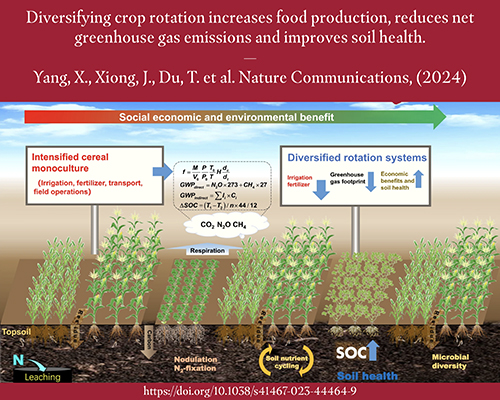Report on Strategic Menu Optimization for Health and Climate Objectives
A United Kingdom-based study investigated the potential of strategic menu reordering within hospital inpatient settings to simultaneously advance public health and environmental sustainability. This report analyzes the study’s methodology, findings, and direct alignment with the United Nations Sustainable Development Goals (SDGs), particularly SDG 3 (Good Health and Well-being), SDG 12 (Responsible Consumption and Production), and SDG 13 (Climate Action).
Study Objectives and Methodology
Primary Objectives
The research aimed to determine if simulation modeling could predict the efficacy of menu optimization in a hospital environment. The core objectives were to quantify potential reductions in:
- Saturated Fatty Acid (SFA) consumption, directly supporting SDG 3: Good Health and Well-being.
- Carbon footprint of meals served, directly supporting SDG 13: Climate Action.
Methodological Framework
The study employed a simulation-based approach using publicly available data from National Health Service (NHS) hospitals. The methodology involved several key steps:
- Data Collection: Researchers gathered weekday inpatient menus from 12 NHS hospitals across UK regions.
- Nutritional and Environmental Analysis: As recipe-level data was unavailable, the carbon footprint and SFA content for each dish were calculated using ingredient lists from a public recipe database (BBC Good Food) and the Klimato environmental impact tool.
- Consumer Preference Modeling: Food preference data was collected from 50 online survey participants to simulate realistic meal choices.
- Optimization Simulation: The model processed 113,400 unique weekly menu combinations (ensuring at least one vegetarian option daily) to identify the menu arrangement that minimized both SFA intake and carbon emissions across the participant group.
Key Findings and Impact on Sustainable Development Goals
Quantitative Outcomes
The simulation modeling demonstrated significant potential for improvement without altering recipes or removing menu items. The key findings for the 11 viable hospital sites include:
- Climate Action (SDG 13): When targeting carbon footprint alone, the model predicted reductions ranging from 12.7% to 29.3%.
- Good Health and Well-being (SDG 3): When targeting SFA consumption alone, predicted reductions ranged from 6.5% to 31.5%.
- Integrated Approach (SDG 3, 12, 13): When minimizing both variables jointly, the model achieved substantial reductions of 9.1% to 29.3% in carbon footprint and 5.0% to 26.5% in SFA intake.
The variation in potential reductions depended on the initial diversity of the menu’s environmental and nutritional impact and how the baseline menu compared to the optimized configuration.
Alignment with Responsible Consumption (SDG 12)
This study provides a powerful model for achieving SDG 12: Responsible Consumption and Production. By altering the “choice architecture” rather than restricting options, the intervention promotes more sustainable and healthier consumption patterns. This approach is non-intrusive and respects patient choice while guiding collective outcomes toward sustainability targets.
Conclusions and Strategic Implications
Strengths of the Optimization Approach
The primary strength of this strategy is its ability to deliver measurable progress on health and climate goals with minimal disruption. Key advantages include:
- No Recipe Reformulation: Caterers are not required to change existing recipes or supply chains.
- Flexibility: The model can be adapted to target other nutritional variables, such as minimizing sugar and salt or maximizing fiber intake.
- Scalability: The principles can be applied to other institutional catering settings, such as universities and corporate canteens, amplifying its potential contribution to the SDGs.
Limitations and Recommendations for Implementation
The authors acknowledge several limitations that must be addressed before real-world implementation.
- Sample Representativeness: The study was limited to hospitals with publicly available menus, and the survey participants were younger than the typical inpatient population.
- Scope of Analysis: The model did not account for side dishes or specialized dietary menus (e.g., gluten-free).
It is recommended that further real-world trials be conducted to validate these preliminary findings. Practical challenges, including logistics, costs, and stakeholder acceptance, must be thoroughly evaluated to ensure the successful rollout of this strategy as an effective tool for advancing the Sustainable Development Goals within the public sector.
SDGs Addressed or Connected to the Issues Highlighted in the Article
SDG 3: Good Health and Well-being
- The article directly addresses this goal by focusing on a strategy to reduce the consumption of saturated fatty acids (SFA) in hospital meals. High intake of SFA is linked to non-communicable diseases, and the study demonstrates a potential reduction of “between 6.5% and 31.5%,” thereby promoting healthier dietary choices and contributing to patient well-being.
SDG 12: Responsible Consumption and Production
- This goal is central to the article’s theme. The study explores “strategic menu optimization” as a form of “choice architecture” to influence consumer behavior towards more sustainable food choices without restricting options. It focuses on reducing the environmental impact (carbon footprint) of food consumed in a large-scale public institution (hospitals), which aligns with promoting sustainable consumption patterns and sustainable public procurement practices.
SDG 13: Climate Action
- The article explicitly connects food consumption with climate change by measuring the “food carbon footprint.” The study’s primary aim is to find ways to reduce these carbon emissions through menu changes. The findings show a “predicted reduction of 12.7–29.3%” in carbon footprint, presenting a practical strategy for climate change mitigation within the food system of public institutions.
Specific Targets Identified Based on the Article’s Content
Target 3.4: Reduce by one-third premature mortality from non-communicable diseases through prevention and treatment and promote mental health and well-being.
- The article’s focus on reducing SFA consumption is a direct preventative health measure. By promoting diets lower in saturated fats, the proposed menu changes can help lower the risk of cardiovascular diseases and other non-communicable diseases among patients, directly contributing to this target.
Target 12.2: By 2030, achieve the sustainable management and efficient use of natural resources.
- Reducing the carbon footprint of food is intrinsically linked to the efficient use of natural resources like land, water, and energy. Foods with a lower carbon footprint are generally less resource-intensive. Therefore, the study’s strategy to lower the carbon footprint of hospital meals supports the more sustainable management of these resources.
Target 13.2: Integrate climate change measures into national policies, strategies and planning.
- The study provides a tangible, low-cost strategy that can be integrated into the operational policies of public institutions like the UK’s NHS hospitals. Implementing such menu optimization strategies on a large scale would represent the integration of climate change mitigation measures into the planning and practices of the public health sector.
Indicators Mentioned or Implied in the Article
Percentage reduction in Saturated Fatty Acid (SFA) consumption
- The article explicitly uses this as a key metric to measure the health benefits of menu optimization. It provides specific quantitative results, stating that the strategy could lead to reductions in SFA consumption “between 6.5% and 31.5%.” This serves as a direct indicator of progress towards healthier diets.
Percentage reduction in carbon footprint
- This is the primary indicator used in the article to measure the environmental impact of the intervention. The study quantifies the success of the menu changes by calculating the “predicted reduction of 12.7–29.3%” in the carbon footprint of meals served. This metric directly measures progress in climate change mitigation efforts within the food system.
Summary of SDGs, Targets, and Indicators
| SDGs | Targets | Indicators |
|---|---|---|
| SDG 3: Good Health and Well-being | Target 3.4: Reduce premature mortality from non-communicable diseases through prevention. | Percentage reduction in Saturated Fatty Acid (SFA) consumption. |
| SDG 12: Responsible Consumption and Production | Target 12.2: Achieve the sustainable management and efficient use of natural resources. | Percentage reduction in carbon footprint of meals. |
| SDG 13: Climate Action | Target 13.2: Integrate climate change measures into national policies, strategies and planning. | Percentage reduction in carbon footprint of meals. |
Source: news-medical.net







